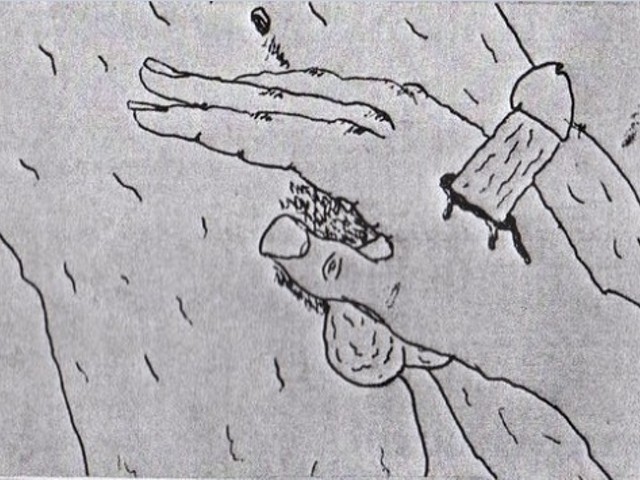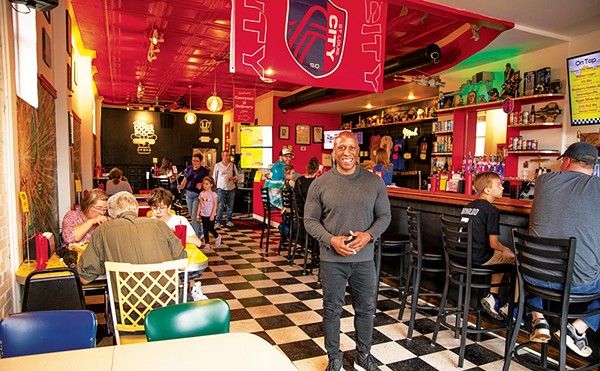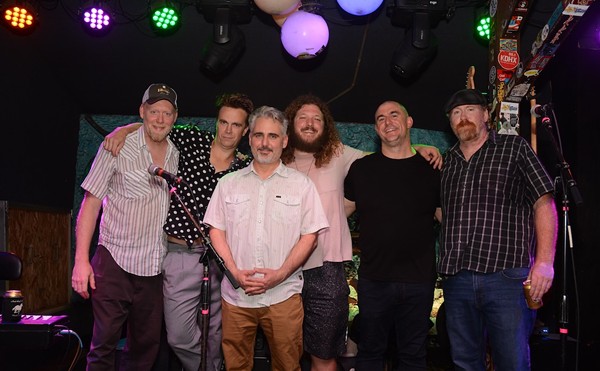In the past few years, St. Louis has seen an explosion of interest in local punk, new-wave and underground records. Labels such as Euclid and BDR have issued archival recordings by 1970s and 1980s groups including the Welders, Max Load, Painkillers and Raymilland, as well as the locally legendary Test Patterns compilation. Sixties-era bands like the Aerovons and Spur have received the reissue treatment.
Yet this doesn't even begin to scratch the surface of the city's musical output. So far, no one has stepped up to release such indescribable local gems as the Lu-Wows' Dream Bubbles ("recorded live at the Flaming Pit"), Don Earl Mabury's Cry Along With Me or the self-titled album by Terry Kratky and Facts O' Life, complete with Funkadelic-esque booty artwork. However, all of them have received a second life this year in Enjoy the Experience, an expansive coffee-table book published by Sinecure Press celebrating the world of "private pressings."
Between the 1950s and well into the 1980s, companies such as Century Records did a brisk mail-order trade in record pressing, often with stock artwork, and would remit however many hundred copies to sell, give away or donate to Goodwill. Anyone with the money to spend could, in this way, become a recording artist. This was DIY in its purest sense: painfully earnest, genuinely sincere, usually just slightly off-kilter, often funny and occasionally transcendent.
Coeditor Paul Major, one of the foremost private pressing collectors, first noticed these quarter-bin treasures while in St. Louis. "I grew up in Louisville, but when I was eighteen, in 1972, I went to Webster College," he recalls. "I was there when it was just a couple thousand people. I lived in St. Louis until 1977. I was in a mid-1970s punk band called the Moldy Dogs. I didn't really know that other people did record collecting at the time, but when I was in St. Louis, like Louisville, I was always looking for odd records. Even back then I would buy private pressings, but I was mostly into psychedelic rock or garage-punk. I was just obsessed with fuzz guitars. And I brought that to St. Louis with me, and I began meeting other local guys who were into what I was into. No one in Kentucky was."
In St. Louis, Major frequented establishments like Webster Groves' Akashic Records, University City's Streetside Records and "a place downtown that also had lots of fishing tackle." He would also take the bus out to various Salvation Army locations and thrift shops. Slowly, collecting these oddball private pressings next to psychedelic and garage rarities, he noticed an aesthetic taking shape.
"I realized that there was something different about these private pressings," he remembers. "Before, I'd just buy records, but I wouldn't distinguish the vanity pressings. I guess I started differentiating in 1976, right around the time I got Ken Higney's Attic Demonstration. It made me wonder what I might have missed during my years in St. Louis, because I was so guitar-oriented."
Intentionally or not, Major stumbled into a collector's market. At the same time he was amassing his collection, East Coast counterparts such as Phil Milstein and Irwin Chusid started spreading the word as well. New Jersey's WFMU (91.1 FM) gladly played the best, worst and most obscure of the lot. For many years, Chusid maintained a weekly WFMU show titled Atrocious Music. (He later softened it to Incorrect Music.) A very few private pressings have been rediscovered as obscure gems, including the Shaggs' Philosophy of the World, the Langley Schools Music Project's Innocence & Despair and Into Outer Space with Lucia Pamela, an otherworldly project by the Miss Saint Louis of 1926.
"I didn't even know about Lucia Pamela back then," Major says. "But eventually, people started to notice these private pressings. 'It's crazy, but really interesting,' they would say."
As file sharing became more prominent, it was suddenly possible to hear such collector's items as Jr. and His Soulettes' Psychodelic Sounds (awesome kid-soul from Oklahoma) and Higney's Attic Demonstration (remarkably morose songs by an ex-trucker). Eventually, Johan Kugelberg, a former officer at Matador Records and a connoisseur of the obscure, came up with the idea of a coffee-table book in tribute to these private pressings.
Enjoy the Experience is more than 500 pages showcasing more than 1,000 albums of every musical genre — and even a few newly invented ones: high school glee clubs, earnest country singers and folkies, lounge bands recorded live at the local Holiday Inn, wannabe Elton John singer/pianists, hypothetical disco hits, retired truckers, accidental psychedelia, Osmonds/Jacksons-style family bands, children's songs and junior heavy metallers. It's an endlessly fascinating document of local music-making, community team building, and thwarted dreams of fame and fortune.
In all, there are about a dozen Missouri-related albums in this book, mostly from St. Louis and the state's central region. (Kansas City has only two: Donna Dee and Dennis' Two Sides Of... and Spirit of Loretto's God's Message Through Song. Southern Illinois has none.) Whether by design or coincidence, the Missouri entries are among the most interesting.
For instance, there's the story of Springfield's Corillions. Consisting mostly of guitarist Marlin Wallace, the Corillions' records are an odd mix of rockabilly, backwoods country and garage-rock. Each LP label includes the phrase "FIGHT COMMUNISM" in big block letters. His liner notes generally consist of paranoid rants about how the Communists had tortured him, stolen his music, attacked him with lasers and placed him in a "red asylum" against his will. Then there's Toni Carroll: Born and bred on the Hill, she was crowned 1950's Missouri Swim Queen for Health before making splashes in New York and Hollywood. Straight from the Ozarks, there's the J Ann C Trio, which recorded an album at Tan-Tar-A, the still-extant Lake of the Ozarks resort.
When asked about individual artists, however, Major gently deflects. "It's really more about the people who made the records than the records themselves," he says. "There will be some records that are acknowledged, like the Shaggs, as classic. But there will be other broken-down lounge bands that aren't astonishing musically, but they do carry the character of the people involved. So the book is not so much a guide to what you're going to like amongst all these records. You will have your own style which you gravitate towards. It's giving equal status to everyone in the book. It's about what they're doing and about their struggle to get their music out there. And it's also about getting to the bottom of why people think they're great now." Indeed, Enjoy the Experience's editors recently presented an album-cover exhibition in New York City, which, by all accounts, was well-attended and enthusiastically received.
Enjoy The Experience is by no means the final word on private pressings. Even as the best-known titles exchange hands for four-digit sums, the very nature of these obscure recordings suggests that the next Shaggs or Lucia Pamela is potentially one flea market, estate sale or Savers trip away from discovery. For Major, however, his next project is to listen to every record in the book that he hasn't already heard. "I'm going through a process of isolating the goodness," he says. "I'm about to start playing every single one of them, which will be a long project."






